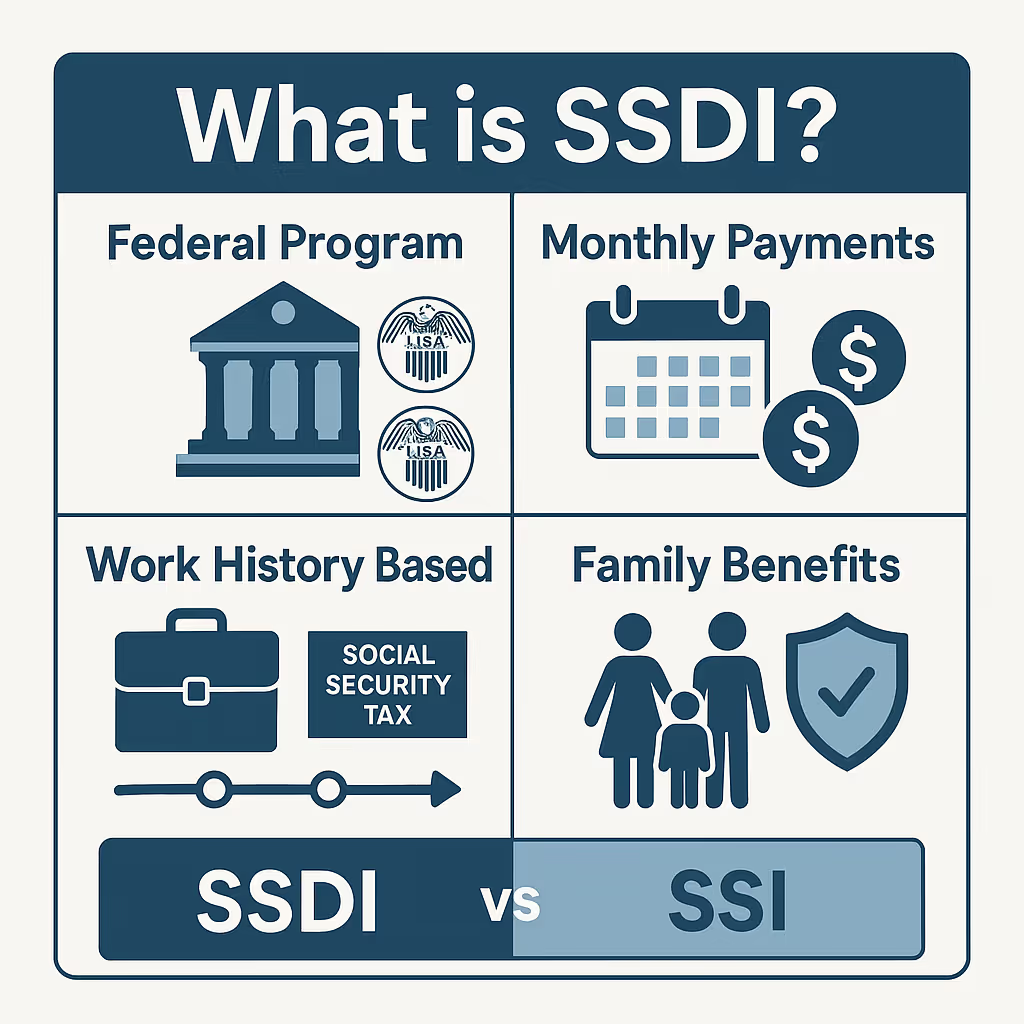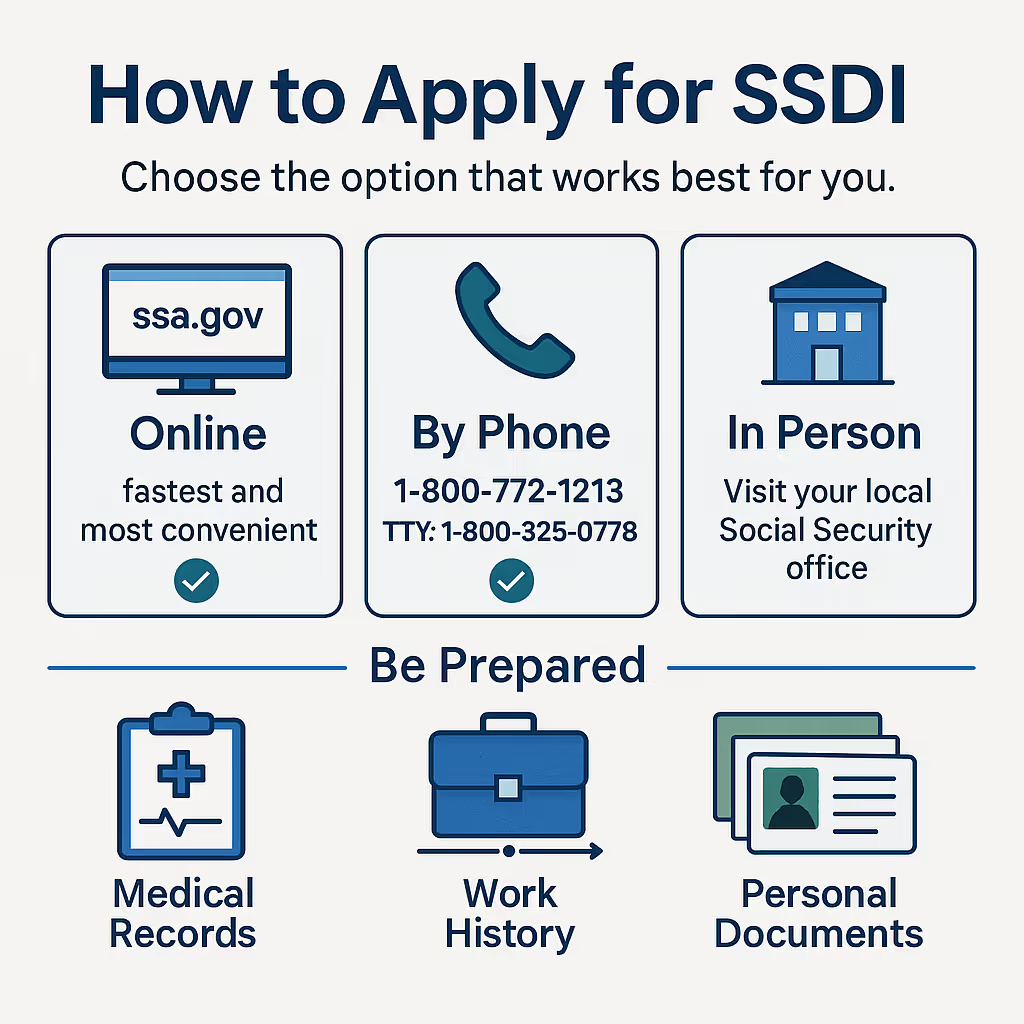Social Security Disability Insurance (SSDI)
Social Security Disability Insurance (SSDI) provides financial support if you’re unable to work because of a serious medical condition. This landing page gives you quick guides, tools, and resources to understand the program, apply successfully, and manage your benefits.

What is SSDI?
SSDI is a federal program that provides monthly payments to people who can’t work due to long-term disability. Unlike Supplemental Security Income (SSI), SSDI is based on your work history and the Social Security taxes you’ve paid. Certain family members may also qualify for benefits.


How to Apply
You can apply for SSDI in several ways. Choose the option that works best for you:
Online: Apply at ssa.gov (fastest and most convenient)
By Phone: Call 1-800-772-1213 (TTY: 1-800-325-0778)
In Person: Visit your local Social Security office
Preparing your medical records, work history, and personal documents ahead of time will help make the process smoother.
Need Help? Let’s Talk
Most people are denied benefits on their first SSDI application. The good news: you can appeal, and having expert
guidance often improves your chances of approval. Our resources can help you through every stage of the process.
SSDI for Back Pain – Get Approved
Back pain is one of the most common reasons for SSDI claims. To qualify, you’ll need medical proof showing how your condition limits your ability to work. Learn what the Social Security Administration looks for in these cases.

Medical Conditions List
Social Security’s “Blue Book” lists many conditions that may qualify for SSDI. Common examples include:
Heart disease and stroke
Cancer
Mental health disorders (depression, anxiety, schizophrenia)
Arthritis and chronic pain
Neurological conditions like MS or Parkinson’s
Even if your condition isn’t listed, you may still qualify if it prevents you from working.

SSDI Application Checklist
Before you apply, gather these key documents to avoid delays:
Proof of identity (birth certificate, Social Security card)
Medical records, test results, and doctor information
Work history for the past 15 years
Recent tax returns or W-2 forms
Military discharge papers (if applicable)
Having everything ready will make your application stronger and easier to process.

Frequently Asked Questions about SSDI
Social Security Disability Insurance (SSDI) provides financial support if you can’t work for at least one year due to a serious medical condition. These social security disability benefits are based on jobs covered by Social Security where you paid taxes. SSDI helps secure income and provides stability during times when employment is not possible.
The amount of your monthly benefits depends on your earnings history, with the average payment around $1,400 in 2025. Some people may also need to pay income taxes on a portion of these benefits if their total income exceeds certain limits. This ensures that social security disability benefits remain fairly distributed based on financial circumstances.
When you reach retirement age, SSDI automatically converts into Social Security retirement benefits. The amount usually remains the same, so you continue to receive benefits without interruption. This transition ensures that individuals with disabilities remain supported as they move from working years into retirement, providing future benefits under the broader social security definition.
By law’s legal definition, SSDI includes a five-month waiting period before benefits begin. This means payments generally start in the sixth month after your disability onset date. The waiting period ensures that only those with long-term disabilities qualify under the eligibility criteria, aligning with Social Security’s requirement that conditions last at least one year or result in death.
Yes, individuals who receive SSDI become eligible for Medicare services after 24 months of disability benefits. This allows access to healthcare regardless of age, ensuring that recipients have medical coverage while unable to work. Medicare is one of the key protections offered by Social Security, alongside monthly benefits and retirement benefits.
Certain members of your family, such as a spouse or children, may also receive benefits based on your record. These payments provide additional financial support to cover essential needs like food and housing. Family benefits are an important part of the program, helping households remain secure when one wage earner can no longer maintain employment.
Yes, individuals who receive SSDI become eligiMental impairment conditions such as depression, anxiety, or schizophrenia may qualify for SSDI if they prevent you from maintaining employment. Social Security evaluates how symptoms affect daily functioning, work performance, and long-term stability. If your condition meets the eligibility criteria, you may receive benefits just as you would for a physical disability.ble for Medicare services after 24 months of disability benefits. This allows access to healthcare regardless of age, ensuring that recipients have medical coverage while unable to work. Medicare is one of the key protections offered by Social Security, alongside monthly benefits and retirement benefits.
You can log in to your Social Security account online to estimate future benefits. This tool helps you understand how much you may receive now or later, whether through disability benefits or retirement benefits. Having access to this information allows you to plan ahead, compare monthly benefits, and ensure you remain financially secure as circumstances change.
Ready to Get Started?
Don’t wait—every month you delay could cost you benefits. Take the first step now and see if you qualify.
